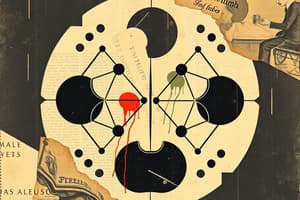Podcast
Questions and Answers
What is the main characteristic of binary fission as a method of cell division?
What is the main characteristic of binary fission as a method of cell division?
- It occurs in eukaryotic cells.
- It requires a complex process of mitosis.
- It involves the formation of four daughter cells.
- It is the simplest and fastest form of reproduction. (correct)
Which phase of the cell cycle constitutes the majority of a cell's life?
Which phase of the cell cycle constitutes the majority of a cell's life?
- Interphase (correct)
- S phase
- Mitosis
- G1 phase
What occurs during the S phase of the cell cycle?
What occurs during the S phase of the cell cycle?
- The cell prepares for division.
- DNA is not replicated.
- Sister chromatids are formed. (correct)
- The cell undergoes cytokinesis.
What is the role of the centromere in chromosomes?
What is the role of the centromere in chromosomes?
Which option best describes the role of interphase in the cell cycle?
Which option best describes the role of interphase in the cell cycle?
What type of cells undergo mitosis?
What type of cells undergo mitosis?
Which of the following statements about the cell cycle is accurate?
Which of the following statements about the cell cycle is accurate?
How many daughter cells are usually formed by binary fission?
How many daughter cells are usually formed by binary fission?
What is the primary purpose of mitosis?
What is the primary purpose of mitosis?
Which phase of mitosis involves the condensation of chromatin into rod-shaped chromosomes?
Which phase of mitosis involves the condensation of chromatin into rod-shaped chromosomes?
During which phase do spindle fibers move chromosomes to the cell's equatorial plane?
During which phase do spindle fibers move chromosomes to the cell's equatorial plane?
What occurs during anaphase?
What occurs during anaphase?
Which structure disappears during telophase?
Which structure disappears during telophase?
What happens to the microtubules of the spindle during anaphase?
What happens to the microtubules of the spindle during anaphase?
How does cytokinesis occur in animal cells?
How does cytokinesis occur in animal cells?
What is the fate of chromosomes during telophase?
What is the fate of chromosomes during telophase?
What structure is formed as microtubules elongate during anaphase?
What structure is formed as microtubules elongate during anaphase?
Which event takes place during prophase that involves the chromosome structure?
Which event takes place during prophase that involves the chromosome structure?
Flashcards
Binary Fission
Binary Fission
The simplest and fastest method of prokaryotic cell reproduction. One cell divides into two equal daughter cells.
Mitosis
Mitosis
A type of cell division that creates two identical daughter cells from one parent cell. Used in eukaryotic cells.
Cell Cycle
Cell Cycle
The repeating sequence of events that make up a cell's life, from its formation until it divides.
Interphase
Interphase
Signup and view all the flashcards
Sister Chromatids
Sister Chromatids
Signup and view all the flashcards
Chromosome
Chromosome
Signup and view all the flashcards
S Phase
S Phase
Signup and view all the flashcards
Centromere
Centromere
Signup and view all the flashcards
Metaphase
Metaphase
Signup and view all the flashcards
Telophase
Telophase
Signup and view all the flashcards
Cytokinesis
Cytokinesis
Signup and view all the flashcards
Chromatin
Chromatin
Signup and view all the flashcards
Centrioles
Centrioles
Signup and view all the flashcards
Spindle fibers
Spindle fibers
Signup and view all the flashcards
Study Notes
Cell Cycle and Mitosis
- Kinds of Cell Division:
- Binary fission: Simplest, fastest reproduction in prokaryotic cells. Parent cell divides into two roughly equal daughter cells. Steps include DNA replication, cell elongation, new cell wall formation between chromosomes, then the cell splits.
- Mitosis: Cell division in eukaryotic cells. Produces genetically identical daughter cells.
- Meiosis: Specialized cell division for sexual reproduction.
Binary Fission
- Occurs in prokaryotic cells.
- Parent cell divides into two daughter cells that are nearly identical.
- Key steps involve DNA replication, cell elongation, division, completion of new wall.
Division in Eukaryotic Cells
- Cell Cycle: Repeating series of events.
- The cell cycle is NOT continuously dividing.
- Cell division is only a part of the cycle. The life cycle of a cell, from its formation to division.
- Divided into Interphase (90%) & Mitosis/Meiosis (10%).
Interphase
- The time between two cell divisions, comprising three phases:
- G1 phase: Cell growth, protein & organelle synthesis.
- S phase: DNA replication - each chromosome makes a copy of itself, becoming double-stranded.
- G2 phase: Cell growth & final preparation for division.
- G0 phase: Non-cycling stage (temporary or permanent; cardiac muscle and nerve cells).
S Phase (DNA Replication)
- Single chromosome becomes a double chromosome (its own copy).
- This happens after Interphase begins
- Sister chromatids are joined together by a centromere. They are genetically identical copies.
Mitosis
- Purpose: Repair and growth.
- Stages:
- Prophase: Chromosomes condense, nuclear envelope breaks down, spindle fibers form, centrosomes move to opposite ends.
- Metaphase: Chromosomes align in middle of cell, spindle fibers attach to centromeres of sister chromatids.
- Anaphase: Sister chromatids separate & move to opposite poles of the cell, pulled apart by shortening spindle fibers.
- Telophase: Chromosomes decondense, nuclear envelopes reform, spindle fibers disappear, new nuclei form. Cytokinesis: Cell membrane pinches inward to divide into two cells (animal/plant differ).
Mitosis: Condensed Chromosome Structure
- Chromosomes are made up of DNA coiled around proteins.
2. MITOSIS
- Purpose: For growth and repair of damage.
- Cell division creating genetically identical two-daughter cells.
Studying That Suits You
Use AI to generate personalized quizzes and flashcards to suit your learning preferences.




